Steven Lyle Jordan's Blog, page 38
October 25, 2014
Person of Interest: Must-Watch SF TV
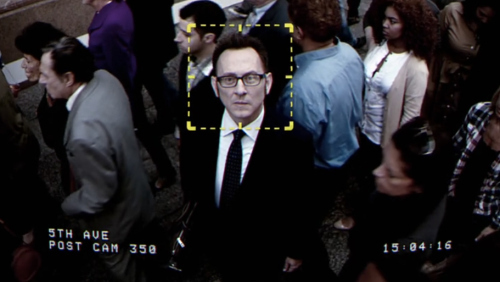
Harold Finch, genius creator of The Machine featured in Person of Interest.
If you want to see the best, most intelligent science fiction to grace our television screens in decades, bar none… I sincerely hope you’re watching Person of Interest. Put simply, this show is what science fiction is supposed to be for.

Shaw and Reese, ex-special-ops agents working for Finch and The Machine
PoI turned out to be the kind of SF show that snuck up on its audiences… which has only added to its power. When it began, it seemed like an odd take on the police detective format, with one character—computer specialist Harold Finch—feeding information to his field operative—ex-special-ops agent John Reese—in order to find that week’s person of interest. That person had been tagged by Finch’s computer, The Machine, to become involved in a violent crime, said prediction based on The Machine’s ability to tap into the audio, video and other electronic feeds that are ubiquitous today, analyzing the data and making deductions about what would happen. Finch and his crew would use the latest technology to tap into the person’s life and learn enough to intercede and save someone’s day.
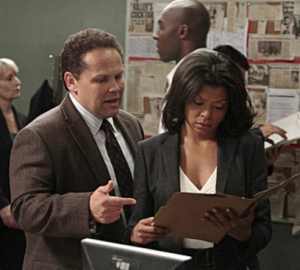
Fusco and Carter, NYPD Detectives assisting the Machine Gang
The first season seemed to be built around the fairly standard “case of the week” scenario, in which Finch would feed Reese enough information to find the person he was after and stop whatever crime was going to happen. At the beginning, the audience (and Reese) didn’t know who Finch was, other than a mysterious man with a literally stiff neck, a lot of money, an incredibly odd computer that didn’t tell him everything, and a hidey-hole in an old library somewhere.
But the background stories, given to us in flashbacks apparently stored by The Machine itself, were the real meat of the show, as we were further introduced to Harold Finch and his past, and learned more about The Machine. We learned that Finch was part of a team laboring to create a truly sentient AI that would work for the government, poring through all available electronic data being collected and communicated, studying it for possible threats to the country, and dispatching agents to quell the threat. In a post-9/11 world, such a goal was more than understandable; but thanks to our post-1984 world, concerns about Big Brother meant the project had to be kept very classified. Not surprisingly, shady government organizations found out and tried to take control of the all-seeing Machine, Finch’s partner was assassinated, and Finch, badly injured after his own failed assassination attempt, had to give up his promising future and go into hiding.
So far, so cliché, really. But it was in its second season that PoI started to show its real science fiction chops. As we watched Finch discover exactly how clever The Machine was, he also discovered that it had imprinted upon him, much like a child imprints on a mother. Finch found himself struggling to prevent The Machine’s getting too intelligent or independent, to avoid its questioning its orders to find persons of interest… and constantly surprised at The Machine’s ability to counter his efforts. The Machine was already growing faster than Finch could contain it, and he constantly worried about the chance that it would go rogue.

Root, her senses expanded by The Machine’s surveillance and input, seems almost omniscient at times.
And The Machine decided that it needed another set of hands: Root, another genius hacker who had discovered on her own that The Machine was out there, was given access to it by The Machine itself. Taking orders directly from The Machine, not through Finch, Root seemed to be able to operate in the real world as if she was a living extension of The Machine, using its senses to see through walls and around corners, anticipate moves and attacks, and act as if she were literally clairvoyant. Root was more devoted to The Machine than Finch, seeing it as her God, and she as her disciple and instrument. And Finch regularly discovered that the tasks The Machine gave Root to accomplish, while often beyond his ken, always served Finch’s desire to help people, maintain his secrecy and the safety of his operatives. Still, Finch and Root regularly disagreed about The Machine’s intentions and actions, as well as the basic nature of the intelligence Finch had created.
Gotten deep enough for you? Then the next step in the series became even deeper, when The Machine took even more initiative, having itself moved into hiding from even Finch to avoid being controlled by government forces; followed by the surfacing of a new machine, code-named Samaritan, which the government chose to take over The Machine’s job under their full control… except that the creators of Samaritan weren’t as altruistic as Finch… and neither was Samaritan. Soon Finch’s worst nightmare, an amoral AI controlled by unscrupulous individuals with their own personal agendas and no moral code, came true. And at this point, the efforts on the street as Reese and their recruited assistants fight the war against crimes has taken a back seat to the real story, the advancement of AI and its ramifications to the world.
The most recent episode has shown Samaritan influence an election; and we discover that Samaritan has done this over 50 times now, cementing its control over the country’s leaders. The Machine continues to hide, to feed info to Finch and the gang, and presumably, to prepare against the eventual assault by Samaritan. And when that happens, there’s no telling what will result. We may be heading for an AI war, with operatives connected to the AIs and acting as their soldiers and literal arms and legs (and guns). Or the AIs may have something completely different in mind, an end game that Finch, Root and the rest of the world can scarcely guess at. In fact, PoI may be heading for a conflict in which humans are not the enemy, but merely collateral damage; how scary is that? We know only one thing: Whatever their plans are, only one of the AIs has humans’ best interests at heart. What we don’t know is what The Machine might consider to be in humanity’s best interests, or whether it may need to make some serious compromises to win the end game.
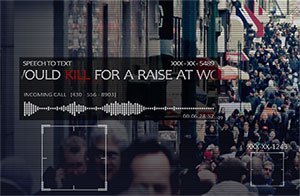 Impressed by Terminator… worried about Skynet? BAH. PoI is more realistic, more likely, and therefore more scary, than any James Cameron notion of human-machine conflicts. PoI is examining machine intelligence, privacy, morals and humanitarianism, and how they will affect our lives and our world. Compared to most TV SF, using analogues, symbolism, nods and winks to create entertaining fables designed to anchor us to commercial breaks… Person of Interest is staring unblinkingly into the eyes of the future we are creating in real life today.
Impressed by Terminator… worried about Skynet? BAH. PoI is more realistic, more likely, and therefore more scary, than any James Cameron notion of human-machine conflicts. PoI is examining machine intelligence, privacy, morals and humanitarianism, and how they will affect our lives and our world. Compared to most TV SF, using analogues, symbolism, nods and winks to create entertaining fables designed to anchor us to commercial breaks… Person of Interest is staring unblinkingly into the eyes of the future we are creating in real life today.
If you want more from science fiction than weird aliens, light sabers and hoverboards—if you want intelligent and well-considered science fiction concepts, and like stories about how those elements will impact our world—you should be watching Person of Interest. If you like writing serious science fiction, you should be watching this show… and taking notes.
(And when you’re done with Person of Interest, you can go catch up on Orphan Black… the second most intelligent SF series on TV.)


Person of Interest: Must watch SF TV

Harold Finch, genius creator of The Machine featured in Person of Interest.
If you want to see the best, most intelligent science fiction to grace our television screens in decades, bar none… I sincerely hope you’re watching Person of Interest. Put simply, this show is what science fiction is supposed to be for.

Shaw and Reese, ex-special-ops agents working for Finch and The Machine
PoI turned out to be the kind of SF show that snuck up on its audiences… which has only added to its power. When it began, it seemed like an odd take on the police detective format, with one character—computer specialist Harold Finch—feeding information to his field operative—ex-special-ops agent John Reese—in order to find that week’s person of interest. That person had been tagged by Finch’s computer, The Machine, to become involved in a violent crime, said prediction based on The Machine’s ability to tap into the audio, video and other electronic feeds that are ubiquitous today, analyzing the data and making deductions about what would happen. Finch and his crew would use the latest technology to tap into the person’s life and learn enough to intercede and save someone’s day.

Fusco and Carter, NYPD Detectives assisting the Machine Gang
The first season seemed to be built around the fairly standard “case of the week” scenario, in which Finch would feed Reese enough information to find the person he was after and stop whatever crime was going to happen. At the beginning, the audience (and Reese) didn’t know who Finch was, other than a mysterious man with a literally stiff neck, a lot of money, an incredibly odd computer that didn’t tell him everything, and a hidey-hole in an old library somewhere.
But the background stories, given to us in flashbacks apparently stored by The Machine itself, were the real meat of the show, as we were further introduced to Harold Finch and his past, and learned more about The Machine. We learned that Finch was part of a team laboring to create a truly sentient AI that would work for the government, poring through all available electronic data being collected and communicated, studying it for possible threats to the country, and dispatching agents to quell the threat. In a post-9/11 world, such a goal was more than understandable; but thanks to our post-1984 world, concerns about Big Brother meant the project had to be kept very classified. Not surprisingly, shady government organizations found out and tried to take control of the all-seeing Machine, Finch’s partner was assassinated, and Finch, badly injured after his own failed assassination attempt, had to give up his promising future and go into hiding.
So far, so cliché, really. But it was in its second season that PoI started to show its real science fiction chops. As we watched Finch discover exactly how clever The Machine was, he also discovered that it had imprinted upon him, much like a child imprints on a mother. Finch found himself struggling to prevent The Machine’s getting too intelligent or independent, to avoid its questioning its orders to find persons of interest… and constantly surprised at The Machine’s ability to counter his efforts. The Machine was already growing faster than Finch could contain it, and he constantly worried about the chance that it would go rogue.

Root, her senses expanded by The Machine’s surveillance and input, seems almost omniscient at times.
And The Machine decided that it needed another set of hands: Root, another genius hacker who had discovered on her own that The Machine was out there, was given access to it by The Machine itself. Taking orders directly from The Machine, not through Finch, Root seemed to be able to operate in the real world as if she was a living extension of The Machine, using its senses to see through walls and around corners, anticipate moves and attacks, and act as if she were literally clairvoyant. Root was more devoted to The Machine than Finch, seeing it as her God, and she as her disciple and instrument. And Finch regularly discovered that the tasks The Machine gave Root to accomplish, while often beyond his ken, always served Finch’s desire to help people, maintain his secrecy and the safety of his operatives. Still, Finch and Root regularly disagreed about The Machine’s intentions and actions, as well as the basic nature of the intelligence Finch had created.
Gotten deep enough for you? Then the next step in the series became even deeper, when The Machine took even more initiative, having itself moved into hiding from even Finch to avoid being controlled by government forces; followed by the surfacing of a new machine, code-named Samaritan, which the government chose to take over The Machine’s job under their full control… except that the creators of Samaritan weren’t as altruistic as Finch… and neither was Samaritan. Soon Finch’s worst nightmare, an amoral AI controlled by unscrupulous individuals with their own personal agendas and no moral code, came true. And at this point, the efforts on the street as Reese and their recruited assistants fight the war against crimes has taken a back seat to the real story, the advancement of AI and its ramifications to the world.
The most recent episode has shown Samaritan influence an election; and we discover that Samaritan has done this over 50 times now, cementing its control over the country’s leaders. The Machine continues to hide, to feed info to Finch and the gang, and presumably, to prepare against the eventual assault by Samaritan. And when that happens, there’s no telling what will result. We may be heading for an AI war, with operatives connected to the AIs and acting as their soldiers and literal arms and legs (and guns). Or the AIs may have something completely different in mind, an end game that Finch, Root and the rest of the world can scarcely guess at. In fact, PoI may be heading for a conflict in which humans are not the enemy, but merely collateral damage; how scary is that? We know only one thing: Whatever their plans are, only one of the AIs has humans’ best interests at heart. What we don’t know is what The Machine might consider to be in humanity’s best interests, or whether it may need to make some serious compromises to win the end game.
 Impressed by Terminator… worried about Skynet? BAH. PoI is more realistic, more likely, and therefore more scary, than any James Cameron notion of human-machine conflicts. PoI is examining machine intelligence, privacy, morals and humanitarianism, and how they will affect our lives and our world. Compared to most TV SF, using analogues, symbolism, nods and winks to create entertaining fables designed to anchor us to commercial breaks… Person of Interest is staring unblinkingly into the eyes of the future we are creating in real life today.
Impressed by Terminator… worried about Skynet? BAH. PoI is more realistic, more likely, and therefore more scary, than any James Cameron notion of human-machine conflicts. PoI is examining machine intelligence, privacy, morals and humanitarianism, and how they will affect our lives and our world. Compared to most TV SF, using analogues, symbolism, nods and winks to create entertaining fables designed to anchor us to commercial breaks… Person of Interest is staring unblinkingly into the eyes of the future we are creating in real life today.
If you want more from science fiction than weird aliens, light sabers and hoverboards—if you want intelligent and well-considered science fiction concepts, and like stories about how those elements will impact our world—you should be watching Person of Interest. If you like writing serious science fiction, you should be watching this show… and taking notes.


October 24, 2014
Ambition
At the heart of the film is the Rosetta comet mission, but the European Space Administration says it’s a larger tribute to how contemporary space exploration is crucial to searching for clues to our own origins.


October 23, 2014
Found in the Boneyard
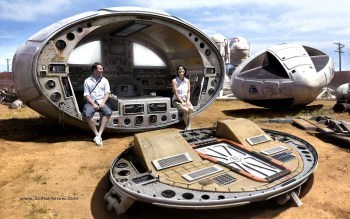 Some people get all the luck, living near areas like the Arizona Boneyard where the cast-aside Eagles from Space:1999 were sent after production. Visitors Michael and Lorelei documented their visit to this spot in the Arizona desert, where arid conditions make it an ideal location to store all kinds of vehicles… even space vehicles.
Some people get all the luck, living near areas like the Arizona Boneyard where the cast-aside Eagles from Space:1999 were sent after production. Visitors Michael and Lorelei documented their visit to this spot in the Arizona desert, where arid conditions make it an ideal location to store all kinds of vehicles… even space vehicles.
Unfortunately, vandals made a mess tagging many of these Eagles, whose parts were used interchangeably during production of Space:1999 and were liberally strewn about the lot. Still, doesn’t seeing them up close bring back the wonder and excitement of seeing these beautiful ships when they flew their historic missions from Moonbase Alpha?
Finally, here is Eagle Four, restored thanks to many of the parts found in the Boneyard, and giving flight tours to this day.
Photos courtesy the Sci Fi Airshow.
(Outstretched cheek courtesy of my tongue.)


October 22, 2014
The REAL elephant in the room
 At a recent meeting of the Woman’s Writing Festival, the future of mainstream publishers was brought up. Though it was a casual comment at first, the subject became more insistent, with some suggesting that soon the majority of books available to the public would be self-published, essentially putting most traditional publishers out of business.
At a recent meeting of the Woman’s Writing Festival, the future of mainstream publishers was brought up. Though it was a casual comment at first, the subject became more insistent, with some suggesting that soon the majority of books available to the public would be self-published, essentially putting most traditional publishers out of business.
Although the discussion of these writers centered around the impact on writers of the traditional publishers’ absence, I don’t see that as the big issue writers should be addressing. A also don’t see the balance between self-published and traditionally-published books to be the big issue. The real issue here is this: When most books available to the public are self-published, how is the public going to find them?
This is the publishing industry’s elephant in the room. In fact, the elephant is itself one of the major accomplishments of the organized publishing industry: The promotional engine of publishing, which extends to magazines and newspapers, billboards, television and Hollywood, the web and social media, and of course, book outlets everywhere. Think about this: If (or when) the traditional publishers someday close their doors and go, that elephant goes with them. What then for the rest of the writers?
Independent authors today struggle for attention in a world that is not yet geared to accept them. Many an author who might otherwise have a good prospect of a successful career face the reality of few or no sales, due primarily to a state of obscurity and isolation from the customers they covet. (Full disclosure: I count myself among them.) Advertising and promotion is the most important thing for an author to conquer, if they want to see sales and gain a consumer base. But presently independent authors are largely edged out of those avenues of advertising and promotion by the traditional publishers’ elephant.
The traditional publishers’ promotional engine is designed to accommodate the traditional publishers, pretty much exclusively. Old relationships, accounts, connections and contracts allow them to pass their products on to venues that are still closed to smaller publishers and independent authors. Those relationships have been cemented by large sums of money changing hands. If that elephant goes, it will create a hole in a number of promotional venues and media, aching to be filled by other material.
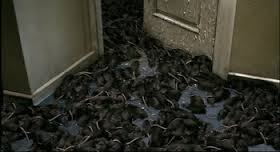
This is the new world of publishing. No wonder that elephant’s scared.
But will independent authors be able to fill those niches? Many of those existing promotional venues are set up for corporate-sized accounts and transactions, something most independents won’t be able to handle. It would be akin to an elephant-sized space being filled with millions of mice instead: Trying to accommodate the difference in scale and the sudden proliferation of individual accounts may simply not be workable for many venues. To access those venues, authors may be able to set themselves up with an advertising co-op that will foot the bill for advertising (at some dividend taken from author sales). But even this would only equate to being, perhaps, a dog-sized entity… nothing compared to that elephant. There’s a more than good chance that many of those big promotional niches will just get swallowed up by other big industries and their elephant-sized pocketbooks. If that happens, what other workable advertising and promotional venues do authors have?
They can certainly try to get noticed on various websites or social media venues; but consumers are already wary of web- and SM-based advertising, and are giving independents very little room to breathe and be noticed (even as corporate advertisers are finding ways—ie, cash—to get forced advertising into those same web and social media venues). And many sites are still dismissing independent authors en masse as amateurs and hacks, refusing to even consider their material or requests for coverage, and subsequently only giving promotional exposure to a small number of authors who either gained fame elsewhere or managed to cultivate an already-established special relationship.
Many other websites have attempted to set themselves up as clearinghouses for authors to sell their wares, giving consumers a one-stop shop to find their authors. Unfortunately, most of these sites haven’t done the greatest job of providing effective search tools for their individual books; and none of them communicate with the myriad of other such clearinghouses. Bottom line, there is still no one place to go to search for authors and certain types of material.
In fact, maybe the one-stop clearinghouse, which at least looks similar to the traditional system we have at present, is the wrong model altogether. It might behoove authors (and their supporters) to think harder about the inherent differences between one big elephant and a roomful of mice, and try to develop a revolutionary new promotional system that takes better advantage of the unique architecture of many smaller, faster and more maneuverable nodes versus one big, slow node. Refined or redesigned search systems, better-interconnected networks or some other promotional strategy may succeed, where existing isolated systems may soon be left behind by the modern consumer.
So how long will it be before consumers find it easy to search their favorite genres, find quality authors and material, and buy or download to their favorite devices? I suspect we’ve still got a long way to go; and as long as the elephant is still here, it will be that much more difficult to make any progress around him.


October 19, 2014
A solution for long-term living on low-gravity planets
We are now very familiar with the fact that living in less than the 1-gee gravity humans were born in, has proven to be hazardous to our long-term health: Muscles weaken; bones thin out; stress is placed on blood vessels; and it can take serious effort to recover from the stays in orbit or on the Moon that put us in a low- or no-gravity situation.
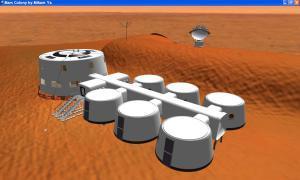
Might be practical… but under low gravity, a long-term stay will make it difficult-to-hazardous to go back home to Earth.
And yet, we are actively talking about returning to the Moon for long-term settlement, and doing the same on Mars… knowing that prolonged exposure on either low-gravity world could make it tough-to-impossible to return to the full gravity of Earth. Are we doomed to extended rehabilitation after every such stay, a “recompression” regimen that could take days, weeks… months?
Maybe not. There is another way to simulate a full Earth gravity on a low-gravity world; a real solution that doesn’t require the invention of gravity-generators or any such hand-wavium. It’s based on two very familiar concepts, one of which has been applied in science fiction regularly, while the other is applied on a regular basis… in amusement parks and on aircraft.
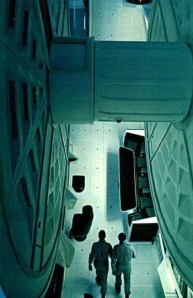
In this “zero-gee” environment, the habitation drum rotates, creating a simulated gravity for the crewmen.
We’ve seen spacecraft in 2001, 2010, Babylon 5, in uncounted novels (including some of mine), etc, utilizing the principle of centripetal force to create an artificial “gravity” aboard a craft: Spin a habitation space at a rate calculated to match one Earth gravity, 9.8 m/s2, and your occupants can move about as if they are on Earth. This method works great in a zero-gee environment like space. But a planet’s surface already has its own gravity, and your spinning habitation ring cannot negate that force as it spins; much like people experience on a roller coaster’s loop, you would be heavier as your ring approaches and rises from the ground, and lighter as you reached the top and proceeded back downward.
But there is a solution: Turn your spinning ring to be parallel to the ground and perpendicular to the planet’s existing direction of gravity. Create a carousel.
 A carousel revolves on its axis, creating its own centripetal force directed outward. Some amusement park rides take advantage of this, spinning fast enough to cause the ride’s seats or cars to tilt outward with the force caused by rotation. What the seats are, in fact, doing is seeking a point at which the downward gravity and the outward centripetal force combine to create a complementary vector of force. The resultant “down” force is at an angle between the outward centripetal force and the downward force of gravity, but to the human body, it feels just like regular gravity directed outward instead of straight down.
A carousel revolves on its axis, creating its own centripetal force directed outward. Some amusement park rides take advantage of this, spinning fast enough to cause the ride’s seats or cars to tilt outward with the force caused by rotation. What the seats are, in fact, doing is seeking a point at which the downward gravity and the outward centripetal force combine to create a complementary vector of force. The resultant “down” force is at an angle between the outward centripetal force and the downward force of gravity, but to the human body, it feels just like regular gravity directed outward instead of straight down.
Aircraft passengers are also familiar with this effect: As a plane banks into a turn, the combination of downward gravity and outward centripetal force create a complementary force that becomes “down” to the passengers, allowing them to continue to stand and move about the cabin, even when the plane is tilted at extreme angles.
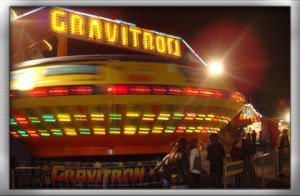 A habitation carousel could accomplish the same effect by anchoring a base to the planet’s surface, then placing the carousel atop it and spinning it up to the appropriate speed to find the complement between the planet’s lower gravity, and the centripetal force of the carousel, to match 9.8 m/s2 and provide a full gravity to its residents. It would look much like a jumbo version of the Gravitron rides at many amusement parks, maintaining a constant spin to simulate gravity on the inside of the structure.
A habitation carousel could accomplish the same effect by anchoring a base to the planet’s surface, then placing the carousel atop it and spinning it up to the appropriate speed to find the complement between the planet’s lower gravity, and the centripetal force of the carousel, to match 9.8 m/s2 and provide a full gravity to its residents. It would look much like a jumbo version of the Gravitron rides at many amusement parks, maintaining a constant spin to simulate gravity on the inside of the structure.
 To the outside, the carousel would look like it had a permanent angle to its body—to insiders, the floor would curve upward (much like the curving floor seen in 2001‘s space station and the spaceship Discovery), but it would curve at an oblique angle. Still, as long as the carousel was large enough to minimize the deleterious effects of rotation on the inner ear (and as long as there were no windows to give away the actual rotational motion), the human body would interpret it as being under one gravity, and one could walk around inside its curved “floor” normally. The hub of a carousel would be a location where inhabitants could go to connect to corridors and move under local standard gravity from one carousel to another, either stacked one atop the other or next to each other as needed or convenient.
To the outside, the carousel would look like it had a permanent angle to its body—to insiders, the floor would curve upward (much like the curving floor seen in 2001‘s space station and the spaceship Discovery), but it would curve at an oblique angle. Still, as long as the carousel was large enough to minimize the deleterious effects of rotation on the inner ear (and as long as there were no windows to give away the actual rotational motion), the human body would interpret it as being under one gravity, and one could walk around inside its curved “floor” normally. The hub of a carousel would be a location where inhabitants could go to connect to corridors and move under local standard gravity from one carousel to another, either stacked one atop the other or next to each other as needed or convenient.
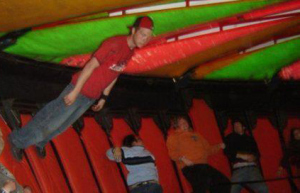
See? It really works!
This relatively simple method of providing a full Earth gee to human settlers would only require familiar mechanical systems to provide rotation. When the first humans arrived on a planet, or perhaps when their robots arrived before them, it would be their job to set up the carousel, get it rotating, and make it ready for permanent habitation.
A future settlement on a low-gee planet might look like this: Imagine that the outer ring of this settlement was moving at just the right rate of rotation to add centripetal force to the existing gravity for a sum of 1 gee for its inhabitants. The hub would not rotate, providing an easy transition from the rotating ring to the non-rotating center and transiting to the rest of the planet. Moving to the central hub (by ladder, or a car that would adjust its tilt to match the apparent gravity at different distances from the center) would enable visitors to come and go, boarding spacecraft or perhaps walking or riding a car from one such settlement to another.
A system like this would thereby allow settlers to avoid the detrimental effects of low-gravity habitation, and make it easier for them to return to Earth when they were ready, fit and healthy as when they left.


October 17, 2014
QMX creates a gorgeous Serenity replica
QMX has decided to torture me with a 1:124 scale replica of Serenity from Firefly, complete with lights, rotating engines, tiny figures that you can suggest positions for inside the ship, an articulated support armature and a light-up base.
 And for less than $7,500 dollars!
And for less than $7,500 dollars!
To which my instant response was: SHUT UP AND TAKE MY—


October 16, 2014
What deep concepts could Star Trek ponder next?
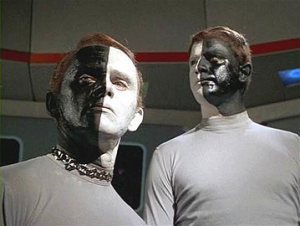 There was an interesting question in IO9’s Postal Apocalypse mailbox this week, which “Postman” Rob Brickman decided to acknowledge as a great question… then pass on answering:
There was an interesting question in IO9’s Postal Apocalypse mailbox this week, which “Postman” Rob Brickman decided to acknowledge as a great question… then pass on answering:
While many issues have been raised about how poorly Star Trek has tackled issues like gender, sexual orientation, and gender identity—and I certainly hope that we eventually get to see Federation citizens pursuing gay relationships and trans* individuals with no one batting an eye—it’s inspired me to wonder about how Star Trek could get out ahead of modern civil rights to tackle something our progressive civil rights movements have not reached yet. We’ve seen this in limited fashion with AI like Data and the EMH, where we explore what it is that constitutes an individual with equal rights and privileges, but I’m wondering about what might come after that. Hive-minds? The transfer of biological consciousness to a synthetic medium?
What’s the next, next generation of science fictiony rights issues that Star Trek could tackle when it someday returns to the small screen? What shape could egalitarianism take on in the 25th century?
I think the takeaway on that is that future fictional postmen in apocalyptic America couldn’t care less about Star Trek. Clearly they realize how dated and obsolete the franchise is by then. Nevertheless, I thought it was a great question, too, and would love to take a crack at a response.
The key to conflicts in Star Trek is that someone in their fictional universe does not have the appreciation for a particular group that present-day viewers have—this is to say, they may react adversely to something the viewer views as okay, or they may be okay with something the viewer views adversely. The original series’ regular mantra was IDIC—Infinite Diversity in Infinite Combinations—and the series did its best to demonstrate that tolerance for all views was the way forward for civilization.
Often, the program placed an antagonist into the story who matched the viewer’s viewpoint, specifically so the show’s protagonist could step up and show the antagonist (and therefore the audience) why their viewpoint should change. Sometimes even the show’s main characters got to be the antagonists who were shown the error of their ways at the end. Star Trek has gotten a lot of ground on this storytelling method, allowing it to frame discussions about war, sex, race, leadership, education, religion, family, and the conception of humanity itself (in sub-themes of machine-life, cloning and alien relations).
It would almost seem that Star Trek has covered just about every area of social conflict there could be (which is surely why Brickman decided not to attempt to answer). But in fact, there are still plenty of areas of future conflict that future episodes of Trek could find itself dealing with.
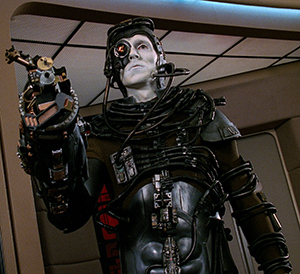 Trek likes to show us adversaries that become friends in time, most notably the Klingon Empire, and other races (like the Romulans) hinted at in brief future-timeline episodes. At present, the single most significant adversary in Star Trek television is the Borg, the humanoid-machine hybrids controlled by a hive-mind that tries to assimilate any encountered life-forms to its own. It would truly be a coup in Trek lore for them to find a way not only to coexist with the Borg, but to work side-by-side and share knowledge… but first, the Federation would need to get over its natural revulsion for the non-aesthetically-modified humanoids and their lack of individual freedom, something humans would see as having been emasculated by machines. Imagine their encountering people who willingly surrendered to the Borg Collective… horrors! Dealing with the significantly different attitude and philosophy of Borg-ness would be a great source of conflict in Trek.
Trek likes to show us adversaries that become friends in time, most notably the Klingon Empire, and other races (like the Romulans) hinted at in brief future-timeline episodes. At present, the single most significant adversary in Star Trek television is the Borg, the humanoid-machine hybrids controlled by a hive-mind that tries to assimilate any encountered life-forms to its own. It would truly be a coup in Trek lore for them to find a way not only to coexist with the Borg, but to work side-by-side and share knowledge… but first, the Federation would need to get over its natural revulsion for the non-aesthetically-modified humanoids and their lack of individual freedom, something humans would see as having been emasculated by machines. Imagine their encountering people who willingly surrendered to the Borg Collective… horrors! Dealing with the significantly different attitude and philosophy of Borg-ness would be a great source of conflict in Trek.
The interface between non-Borg Man and Machine is likely to create schisms between haves and have-nots, between those whose augmented intelligence allows them benefits that others cannot attain. If this creates a schism in society as well, how will Trek’s citizens react to the engineered superiority of these humans? Will non-augmented people be looked down upon, considered inferior, treated as inferiors? Will augmented people be considered as taking unfair advantage over non-augmenteds?
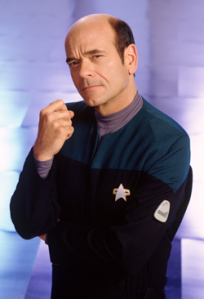 Trek has also investigated the rights of sentient machines, like Lt. Data and the Emergency Medical Hologram (aka The Doctor), from time to time. If such machines become mode commonplace, capable of very different abilities that humans won’t be able to match or surpass, will they inspire prejudice against them? Will they be given the same rights as humans, given that they only simulate humans? Or do machines deserve a completely different set of rights?
Trek has also investigated the rights of sentient machines, like Lt. Data and the Emergency Medical Hologram (aka The Doctor), from time to time. If such machines become mode commonplace, capable of very different abilities that humans won’t be able to match or surpass, will they inspire prejudice against them? Will they be given the same rights as humans, given that they only simulate humans? Or do machines deserve a completely different set of rights?
That pretty much covers machines and machine-organic hybrids… but that’s by no means everything in Star Trek that could create conflict. For instance, any alien races that were seen as valuable in the Trek universe, but at the same time co-opting or consuming some other life form by their very nature in order to survive, would recall the modern revulsion for slavery/destruction of sentient beings. Imagine a great race that could only survive through cannibalism… what great meat for Trek stories that would be.
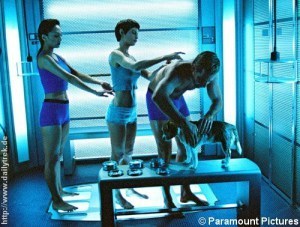
Yes, I went looking for a good Star Trek image that would illustrate the point of non-standard-humans sex. This was the closest I could find. I’ll do better next time.
So far, Trek has trod lightly around the idea of sex: It has done little to acknowledge sexual systems or organisms significantly different from the human norm. But while sex may be a lesser aspect of some races, we should assume that it could be a more overt aspect of others, maybe even something other races habitually do in public or in unexpected situations. And we should assume that there are many more sexual combinations beyond the bisexual human standard, and even its occasional derivations.
If other races’ sexual traits and practices were significantly different from humans’ practices, would it impact their living and working together? Would certain races be banned from certain places and activities due to what they see as natural behaviors for them? Could humans be similarly banned from certain alien areas for essentially the same reason (being too sexually promiscuous, or sexually immature)? Suppose we knew an alien race of four separate bodies, four sexes, always joined together when they work (essentially, having sex everywhere they go, even on the job)… would humans be able to deal with that? Would we see them differently during the rare moments when they separated from each other?
And there is still plenty of ground to cover vís-a-vís aliens that are so significantly different from us as to be almost impossible to communicate with, or even to recognize as beings: If something they did was threatening to us, would we have the right to stop them? The original series episode “Devil in the Dark” dealt with the existence of a creature humans could barely communicate with, the Horta. But at the end of the episode, it was determined that the Horta and humans could comfortably cohabit the same planet. Suppose that were not the case, and the humans would face the question of destroying the creatures, or abandoning years of work and great financial expenditures and leaving a planet they saw as being very valuable to them? Do we abandon an island infested with ants, or do we break out the bug spray? What if that island is covered with diamonds, and the creatures are sentient bacteria?
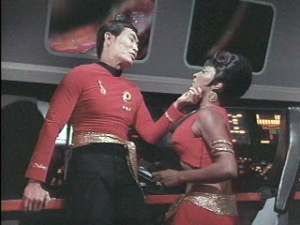 Star Trek has occasionally visited an alternate reality (known as the Mirror Universe), where life in the Federation is not nearly as idyllic as it is in our universe. But should we judge the other universe as wrong because it’s different from ours? Do we have a right to interfere in the other universe? If we knew of a Mirror Universe leader who was the equivalent of Hitler, would those in our universe be bound to try to stop him… even to kill him? Or should we create an underground railroad designed to shunt as many people in the Mirror Universe over to our own to “save” them? Would we be in the right to impose our values upon them? And if so, what would prevent them from coming over here and taking our people away from this “idyllic life” and to their “more sane and proper” dictatorship?
Star Trek has occasionally visited an alternate reality (known as the Mirror Universe), where life in the Federation is not nearly as idyllic as it is in our universe. But should we judge the other universe as wrong because it’s different from ours? Do we have a right to interfere in the other universe? If we knew of a Mirror Universe leader who was the equivalent of Hitler, would those in our universe be bound to try to stop him… even to kill him? Or should we create an underground railroad designed to shunt as many people in the Mirror Universe over to our own to “save” them? Would we be in the right to impose our values upon them? And if so, what would prevent them from coming over here and taking our people away from this “idyllic life” and to their “more sane and proper” dictatorship?
Okay, here’s one that seems light-hearted at its base, but may be the most game-changing of all: Suppose animals were given the ability to talk? Suppose someone had invented a way to interpret the thoughts and feelings of your cat, and translate those into actual words, to the extent that you could converse with your pet? If we suddenly discovered that our pets were more aware of the world and their surroundings than we supposed they were, would it be right to keep them as pets any more? Should we treat them as less-intelligent equals, deserving of our protection, like children? Should we let them go their own way? And once we know they understand us completely, should we demand more of them as our companions… would they graduate from pets to servants?
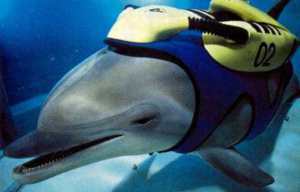 Seaquest DSV‘s dolphin Darwin wasn’t a pet; it was a full member of the crew (with rank). Simians, birds, dogs and rodents* might prove to be capable of working alongside humans. Would better communication allow us to elevate animals to the status of our equals… or would humans continue to see them as lesser creatures next to us? (Seaquest never presented a story where Darwin refused an order or demanded shore leave… what would have been the response?)
Seaquest DSV‘s dolphin Darwin wasn’t a pet; it was a full member of the crew (with rank). Simians, birds, dogs and rodents* might prove to be capable of working alongside humans. Would better communication allow us to elevate animals to the status of our equals… or would humans continue to see them as lesser creatures next to us? (Seaquest never presented a story where Darwin refused an order or demanded shore leave… what would have been the response?)
And this is a mere scratching of the surface of a few obvious civil rights issues Star Trek could cover. Clearly there is enough ground to cover a decade or two of future Star Trek episodes.
* You thought I was gonna say racoons, didn’t ya? Didn’t ya?


October 13, 2014
I don’t “celebrate” Columbus Day.
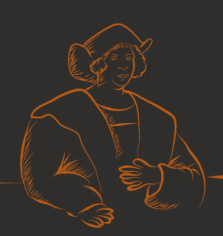 I don’t see Columbus Day as a day deserving of celebration. Here’s why. Have some truth with your nursery rhymes.
I don’t see Columbus Day as a day deserving of celebration. Here’s why. Have some truth with your nursery rhymes.
Note: Less than a year after the publication of this comic, Columbus Day was renamed to Indigenous People’s Day in Seattle. Good going, Seattle.


October 11, 2014
Misplaced fault
 A recent New York Times article has captured energy aficionados’ attention for proclaiming that solar panel users have, for years, been doing it wrong. The article maintains that pointing solar panels south, where they are exposed to the maximum of sunlight, actually means that they are not absorbing the maximum amount of energy at the time of day when it’s needed… specifically, the afternoon and evening when home energy usage is at its highest. And they say this is bad. Bad.
A recent New York Times article has captured energy aficionados’ attention for proclaiming that solar panel users have, for years, been doing it wrong. The article maintains that pointing solar panels south, where they are exposed to the maximum of sunlight, actually means that they are not absorbing the maximum amount of energy at the time of day when it’s needed… specifically, the afternoon and evening when home energy usage is at its highest. And they say this is bad. Bad.
Their reasoning is that, because solar panels are taking overall energy demand from the grid, it is forcing us to shut down or run at lower efficiency our big power plants, and less efficiency costs money. Also, when the peak demand is high, we must supplement this need by burning natural gas, which means we’re out fracking for more, and threatening our environment unnecessarily.
So, the low efficiency usage of existing power plants, and the need for fracking, are based on solar panels facing the wrong way.
I see what you did, there.
So, NOPE. The fault here is not with solar panels. The fault is with an entire industry set up on a stupid assumption (not to mention a news service parroting a party line).
Here’s the real problem with the energy industry, and it has been from the very beginning: It is based around the model of generating power only when it is needed… as opposed to storing power to release when it is needed. In short: Batteries; an invention perhaps 2,000 years old; the main source of electricity in this world before the development of electrical generators and electrical power grids around the end of the 19th century; and which have been woefully ignored, thanks to those selfsame electrical generators and power grids, since the 19th century.
Today’s battery technology is largely based around a few mostly simple electrochemical reactions. In fact, one of the most complex and sophisticated machines in the world, the automobile, is still generally using the venerable lead-acid chemical reaction in its battery to support the vehicle’s electrical system (after the electric generator attached to the internal combustion engine).
Why is this so? Because the electric industry has built its production and profit model around generating power when needed, building large plants to satisfy peak power needs, and finding ways to make variations in power demands work in their advantage, gaining peak prices off of off-peak periods, and overbuilding to account for worst-case power scenarios that actually happen very seldom. Simply put, they have created an industry that only supports generating power on-demand, not storing power away for peak periods, the way almost every other industry in the world knows how to do… including other utilities, like water and gas.
But over the last half of the twentieth century to today, scientists, engineers and homeowners have been experimenting with battery technology, to replace internal combustion engines, to power electronics longer, and to provide a buffer to energy use in the home. Many solar power users, in fact, are highly experienced with using a bank of batteries to store the energy their cells generate during the day, when peak solar gain is available, to release it again only when the household needs it.
The electric utilities even “encourage” solar panel users to plug into the power grid and pump their excess energy back to the power company. Not for them to store it, because they can’t—so they send it back out for some other household to use, while they charge the household full prices, and give you a fraction of that price for the power you gave them.
But today scientists and engineers are developing new battery technologies designed to charge and discharge faster and more efficiently, and to hold more energy per cell and square meter, than ever before. And this is something the energy industry doesn’t want you to know about, because it means you can get your power from sources other than them. So they actively discourage the use of batteries, they help to publicize the occasional battery malfunction or explosion, and they downplay the potential danger of thousands of watts pouring into your home from ancient electrical lines.
The industry could build plants designed to operate at one level, the most efficient level, and build battery banks and other storage systems to store power to be released at peak times. But this would be more efficient than profitable… so, to them, it’s out of the question. And we, the consumer, our finances, and our environment, suffer as a result of their greed.
We should not allow the energy industry to pull the wool over our eyes and hide from us the technologies that will enable us to be more efficient and independent. Battery technology is in dire need of the maximum support for R&D, manufacturing and deployment around the world, at the federal, state, local and personal levels. Battery technology would ease all of our need for peak-level power, make it easy for individuals to create and store their own power, ease pressure on an already-overtaxed electrical grid, save money at the household level, and decrease the hold the power industry has over consumers.
Solar panel users: You keep pointing those panels at the sun, and get your maximum power. Then store it yourself in a battery bank; don’t just give it to the power company to squander for pennies in compensation. And tell the New York Times what it can do with its advice about solar panel use.










